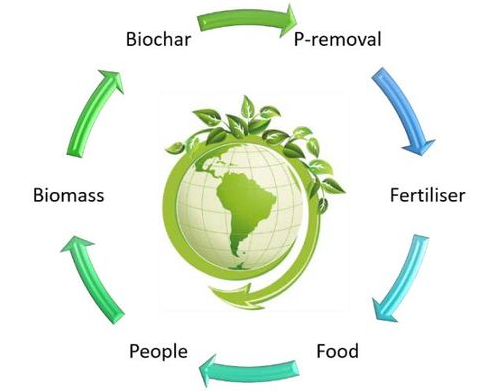Research and Innovation Services Partner with us Our Technologies Circular Economy of Phosphorus and Nitrogen
Circular Economy of Phosphorus and Nitrogen
- Future Students
- JCU Global Experience
- International Students
- Open Day
- How to apply
- Pathways to university
- Virtual Open Day
- Living on Campus
- Courses
- Publications
- Scholarships
- Parents and Partners
- JCU Heroes Programs
- Aboriginal and Torres Strait Islander in Marine Science
- Elite Athletes
- Defence
- Current Students
- New students
- JCU Orientation
- LearnJCU
- Placements
- CEE
- Unicare Centre and Unicampus Kids
- Graduation
- Off-Campus Students
- JCU Job Ready
- Safety and Wellbeing
- JCU Prizes
- Professional Experience Placement
- Employability Edge
- Art of Academic Writing
- Art of Academic Editing
- Careers and Employability
- Student Equity and Wellbeing
- Career Ready Plan
- Careers at JCU
- Partners and Community
- JCU-CSIRO Partnership
- Alumni
- About JCU
- Reputation and Experience
- Chancellery
- Governance
- Celebrating 50 Years
- Academy
- Indigenous Engagement
- Education Division
- Graduate Research School
- Research and Teaching
- Research Division
-
Research and Innovation Services
- About Research and Innovation Services
- Partner with us
- Innovate with us
- Research Grants, Tenders and Funding
- Ethics and Research Integrity
- Research Contracts
- Discover our Research and Testing Facilities
- JCU Ideas Lab
- Find an Expert
- Contact Research and Innovation Services
- FAQs and Fact Sheets
- GECO
- CASE
- College of Business, Law and Governance
- College of Healthcare Sciences
- College of Medicine and Dentistry
- College of Science and Engineering
- CPHMVS
- Anthropological Laboratory for Tropical Audiovisual Research (ALTAR)
- Anton Breinl Research Centre
- Agriculture Technology and Adoption Centre (AgTAC)
- Advanced Analytical Centre
- AMHHEC
- Aquaculture Solutions
- AusAsian Mental Health Research Group
- ARCSTA
- Area 61
- Lions Marine Research Trust
- Australian Tropical Herbarium
- Australian Quantum & Classical Transport Physics Group
- Boating and Diving
- Clinical Psychedelic Research Lab
- Centre for Tropical Biosecurity
- Centre for Tropical Bioinformatics and Molecular Biology
- CITBA
- CMT
- Centre for Disaster Solutions
- CSTFA
- Cyclone Testing Station
- The Centre for Disaster Studies
- Daintree Rainforest Observatory
- Fletcherview
- JCU Eduquarium
- JCU Turtle Health Research
- Language and Culture Research Centre
- MARF
- Orpheus
- TESS
- JCU Ideas Lab
- TARL
- eResearch
- Indigenous Education and Research Centre
- Estate
- Work Health and Safety
- Staff
- Discover Nature at JCU
- Cyber Security Hub
- Association of Australian University Secretaries
- Services and Resources Division
- Environmental Research Complex [ERC]
- Foundation for Australian Literary Studies
- Gender Equity Action and Research
- Give to JCU
- Indigenous Legal Needs Project
- Inherent Requirements
- IsoTropics Geochemistry Lab
- IT Services
- JCU Webinars
- JCU Events
- JCU Motorsports
- JCU Sport
- Library
- Mabo Decision: 30 years on
- Marine Geophysics Laboratory
- Office of the Vice Chancellor and President
- Outstanding Alumni
- Pharmacy Full Scope
- Planning for your future
- Policy
- PAHL
- Queensland Research Centre for Peripheral Vascular Disease
- Rapid Assessment Unit
- RDIM
- Researcher Development Portal
- Roderick Centre for Australian Literature and Creative Writing
- Contextual Science for Tropical Coastal Ecosystems
- State of the Tropics
- Strategic Procurement
- Student profiles
- SWIRLnet
- TREAD
- TropEco for Staff and Students
- TQ Maths Hub
- TUDLab
- VAVS Home
- WHOCC for Vector-borne & NTDs
- Media
- Copyright and Terms of Use
- Australian Institute of Tropical Health & Medicine
- Pay review
Background
Phosphorus (P) scarcity and eutrophication of water streams are two major problems affecting the management of agricultural resources. Proper management of phosphorus is fundamental to achieve and maintain food security, especially in countries without phosphate mines, and in mitigation of environmental impacts in coastal zones, such as the Great Barrier Reef. Over the last two decades, the number of technologies for phosphorus recovery has significantly increased, however some of these have drawbacks. For example; need for high amounts of chemicals and in the case of wastewater treatment plants, promotes significant increase of biosolids. Phosphorus and nitrogen removal using low-cost adsorbents is considered as a potential environmentally friendly solution for nutrient recovery.
James Cook University have developed biochar from different biomass feedstock (such biosolids, algae, wood, etc.) through the process of SCB pyrolysis. As an example, in the region of North Queensland, one selected and readily available source of biomass is sugarcane bagasse (SCB) and the biochar produced from this biomass has a high adsorption coefficient. The final product (biochar + nutrients) can be used as a fertiliser.
Using biochar produced from SCB pyrolysis solves the problem of biomass waste, nutrient run-off and creates a slow-release fertiliser. Biochar is characterised by high porosity and carbon content, which makes it a good soil ameliorate. Besides, the direct environmental benefits of biochar, the gas fraction produced from pyrolysis can be used as energy production.
Further Details
Antunes, Elsa, et al. “Biochar produced from biosolids using a single-mode microwave: Characterisation and its potential for phosphorus removal.” JEMA 196 (2017): 119-126.
Antunes, Elsa, et al. “Isotherms, kinetics and mechanism analysis of phosphorus recovery from aqueous solution by calcium-rich biochar produced from biosolids via microwave pyrolysis.” JECE 6.1 (2018): 395-403.
- Nutrient recovery with zero environmental impact
- Production of slow-release fertiliser
- Mitigate environmental impact of nutrient run-off in the Great Barrier Reef
This concept of nutrient recovery using biochar has important applications, including:
- Wastewater Treatment Plants
- Agriculture
- Food industry
JCU has the expertise and facilities to produce biochar and test (batch or continuous mode) nutrient recovery. Currently seeking industry partners to explore this research area for their specific applications.
Seeking:
- Commercial partner
- Development partner
- Copyright
- Know-how based
